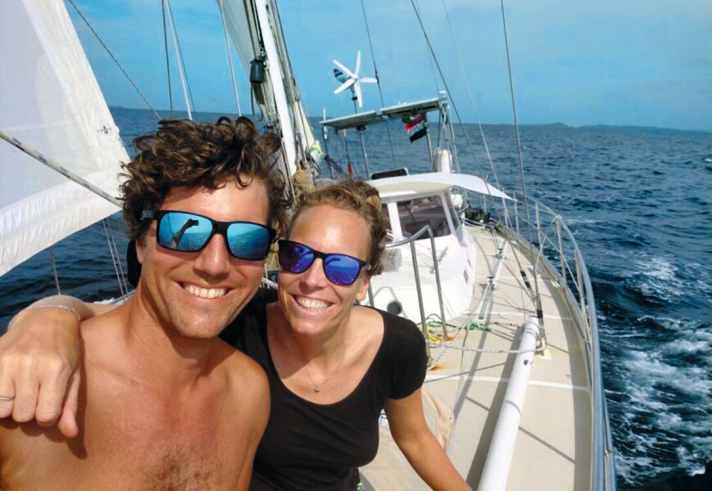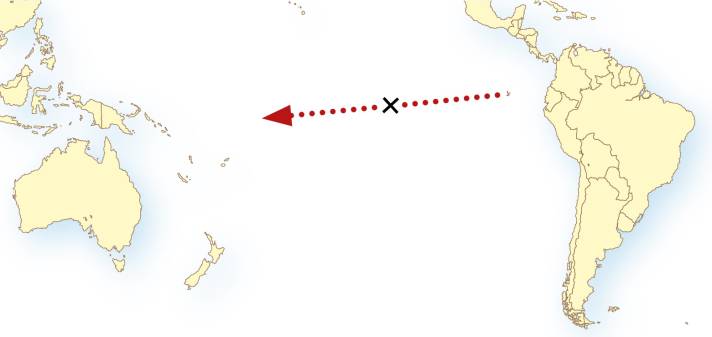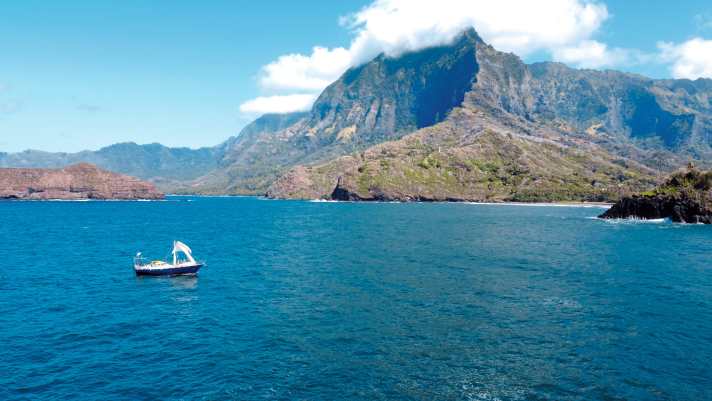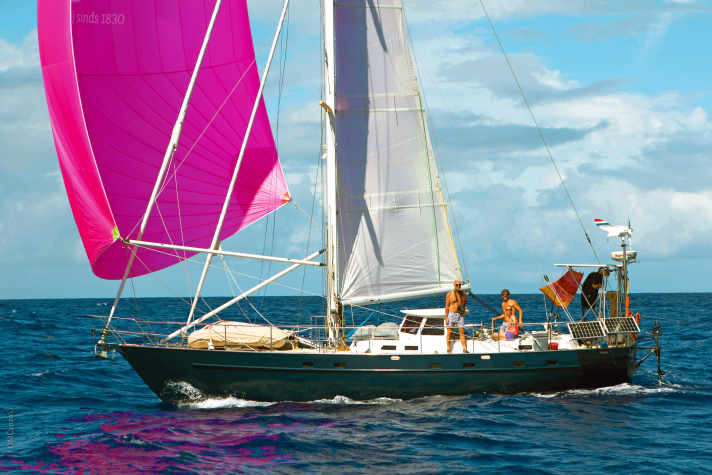
Nobody wants to experience that: Well prepared, the Dutch circumnavigators Yvette Oeben and Alexander Droog set off from Galapagos on their Pacific crossing (www.blueberylsailing.com). But after a week of calm sailing, their mast suddenly goes overboard with a loud crash. Returning to Galapagos against the wind is not an option for the two of them. Equipped with a good dose of courage and ingenuity, they build an emergency rig for their Koopmans 44. Ahead of them lie 24 days of slow sailing in extremely difficult conditions. They reach Hiva Oa in French Polynesia unscathed. But even after their happy arrival, the adventure is not over. In this interview, they talk about how they overcame the challenges of the difficult passage and what comes next for them.
YACHT: When and how did the mast break?
Alexander Droog: On 22 April we were sailing in 17 knots of wind with reefed sails - there was a nice breeze and about two metres of swell. Everything went well until five or six in the morning. I was sitting at the chart table during my watch and suddenly heard a big noise, as if something had crashed onto the boat. When I looked out of the companionway, I saw that the mast had come down.
Yvette Oeben: I also woke up from the huge noise and shouted: "What's that, what's that?", and Alex shouted back: "The mast is overboard. Put on your lifejacket, we have to check it out!"
Alexander: We had to survey the damage quickly. From one moment to the next, we no longer had control of the boat and we had to regain it quickly. So first of all, we looked to see if there was any damage to the hull. Fortunately, this was not the case.

What did you do then?
Alexander: We first loosened part of the rigging so that the mast no longer hit the boat uncontrollably. Then we called my father Rob. He is accompanying our trip from home. He said we should try to save the mast and as much material as possible. That's what we tried to do. But we could only cut off a piece of the foresail. The mainsail was hanging low in the water and was holding the mast down. With two metre waves, it was too dangerous to go into the water and cut it off. After three hours of hard work, we gave up trying to recover the main or the mast.
So you cut the rig?
AlexanderYes, it was even easier than I had expected. I tightened the forestay over the winch and released the pressure. I was then able to unscrew the terminals. I didn't even need an angle grinder or a shroud cutter.
Without a mast in the middle of the Pacific - what was going on inside you?
Alexander: Well, at least I wasn't afraid. The hull was undamaged. That's why I didn't think for a second about leaving the boat. Yvette, on the other hand, did.
Yvette:That's right. Not on the first day, but later. At first I probably had so much adrenalin that I wasn't scared either. It was more of a shock. It was only afterwards, when I realised what had happened, that I got scared. I imagined how long the journey would take and feared that more things might break. I had panic attacks and couldn't sleep for a long time. I really wanted to get off the boat. On the other hand, I didn't want to leave Alex alone. We finally decided to sail the boat back together, first to French Polynesia and then eventually home to the Netherlands.

How did you proceed from there?
Yvette: Alex made the best of the situation. In the morning, we had separated the mast from the boat, and by lunchtime he had already planned and erected the emergency rig. When we refitted our Blue Beryl in 2018, we kept a lot of old ropes and other materials and stowed them in the boat. I jokingly said at the time that we could easily equip a second boat with it. Little did I know that this would be our good fortune: After cutting the new halyards, we were able to build our emergency rig from all the old parts and sail at three or four knots after all. So there was actually no realistic reason to be afraid. Nevertheless, the situation was frightening for me.
What was the worst thing about travelling under emergency rigging?
Yvette: The constant rolling of the boat. And knowing that the destination is far away.
Alexander: Our spinnaker pole, which we used to build the rig, is not much more than a toothpick. Without a proper mast, the boat was completely out of balance. It's hard to imagine: It lurched and banged from left to right day and night, taking on water again and again. The waves came from both sides. When they crashed against the hull, it made a deafening noise. It was terrible!
That sounds enormously exhausting ...
Alexander: Absolutely! Every movement was exhausting. Luckily we had prepared food: Pre-cooked food in the freezer and tinned meals. It was quick to prepare. Reheating was only one problem anyway. The food itself was also a challenge: you're simply not hungry or thirsty in a situation like this. You have to force yourself to eat and drink something. And the flavour is completely different.
Yvette: That's true. What you normally like to eat suddenly no longer tastes good. For example, we had bought a lot of eggs, which I always like. But I didn't like them at all when we were travelling. What's more, it was difficult to eat and drink at all with all the rocking. I was a bit seasick the whole time. When we arrived on Hiva Oa, we carefully tried different things again. And lo and behold, it tasted good again.

How did you manage to get through this ordeal and, above all, keep your spirits up?
Alexander: We stuck to the facts. That's my kind of optimism. The hull was okay, we had our emergency rig, we were travelling three or four knots in the right direction. We had a satellite phone and enough to eat and drink for months. We kept telling ourselves: "We've made it another hour or another day. And we're healthy." The journey wasn't impossible, it was just extremely uncomfortable.
Yvette: We kind of made a little joke out of it and said every day: "Okay, this is another day when we have to keep ourselves alive. We have to eat, drink, try to sleep and go to the toilet. If we can do all that, it's a good day."
A YouTube video shows that you were visited by another boat on the way. How did that happen and what was it like for you?
Yvette:That was great! We were actually joined by other sailors from time to time who had heard about our misfortune. I thought about going over to them a few times. That was my backup plan for a day or two. But I also knew that I couldn't really do that. I couldn't leave Alex alone. If a boat was gone again and I knew another one was coming in a few days, I thought: "Okay, in four days you'll have another chance to continue on an intact boat." Although I never did, I held on to the option. That reassured me.
Alexander: Because of the high swell, the other sailors could never get close to us. But they sent us diesel, provisions and sweets on long lines. We didn't really need provisions, as we had enough of everything. It was good to have spare diesel, but we only motored for two and a half days in total. In reality, the most important thing was that we didn't feel alone on the big ocean. Support from other sailors, including by radio or satellite phone, is the best thing that can happen to you in a situation like this.

Given the circumstances, was there anything good about the trip?
Alexander (laughs): The arrival!
Yvette: My captain! It's admirable how he mastered the situation. He is a determined man of action and gave me courage. He made sure that we arrived safely here in Hiva Oa. I found the situation extremely difficult. The panic attacks, the agonising over food and the poor sleep: it was way out of my comfort zone. I never liked ocean passages, now I hate them!
How does it feel to be back on land?
Yvette: Wonderful!
Alexander: That's right. But we're not in a party mood. It's good to have some peace and quiet, talk to family and friends and recover a little - even from the disappointment. We had prepared the boat so well! We had a new rig, we had reefed the sails and we had a nice course. Before every passage that lasts longer than 24 hours, I check the rig from the foot to the masthead. That was also the case in Galapagos. And then something like this happens anyway! We've been sitting here on Hiva Oa for a fortnight and have seen many a boat arrive where we are surprised that it has survived the passage without major damage. The journey is already very demanding with an intact mast. On top of that, we now have a lot to sort out and are up early every day. The insurance company doesn't want to cover the damage. So we have to find a new mast somehow.
Yvette: We are on our own, very far away from everything. There is no professional here to help us. So we have to manage everything ourselves, which is pretty hard and takes a lot of energy.
Do you still get help from other sailors?

Yvette: Yes, the sailing community is really very helpful. But there's not much they can do. After all, it's the entire mast that's gone, not just a wire or a screw that people can quickly help each other out with.
Alexander: I have now spent the first two weeks here on land trying to find at least a temporary replacement mast. On a remote island, the mast of a sunken boat was lying on a small beach between high rocks. We travelled there in another boat, swam through the surf to the beach and swam back with the mast. That was another adventure! At least we now have a mast, albeit without any accessories. No terminals, no shrouds. But we still hope to be able to put it up in the next two weeks.
What should happen next?
Yvette: For now, we only have a temporary mast. We'll use it to try to get away from these small islands. There's no material to buy here, far and wide. So we want to sail to Tahiti in the hope of getting a decent mast and accessories there.
Alexander: But we don't yet know whether we'll be able to raise the money. Friends have started a crowdfunding campaign and some companies want to sponsor us. We are also in talks with the insurance company. It remains exciting. If we succeed, we'll slowly sail on to New Zealand by the end of 2023 and then home at some point.
How does the thought of another ocean passage make you feel after the experience?
Yvette: I don't think I'll cross an ocean again. But that's what I thought after crossing the Atlantic. And then I did it again. There is this sailor's dementia that makes you quickly forget the exertions. But this passage really was a trauma that I won't forget in a hurry. I've only known life on a boat and sailing since I met Alex six years ago. I come from a family of landlubbers. Sailing is not in my DNA.
Alexander: That's what Yvette always says. She has more experience than most sailors in Europe. But it will indeed be difficult to get her out on the ocean again. I myself grew up on the water and will definitely continue sailing. Fortunately, my father loves long ocean passages. He and some of my friends will certainly accompany me if necessary.
Video of the "Blue Beryl" crossing the Atlantic when everything was still good

